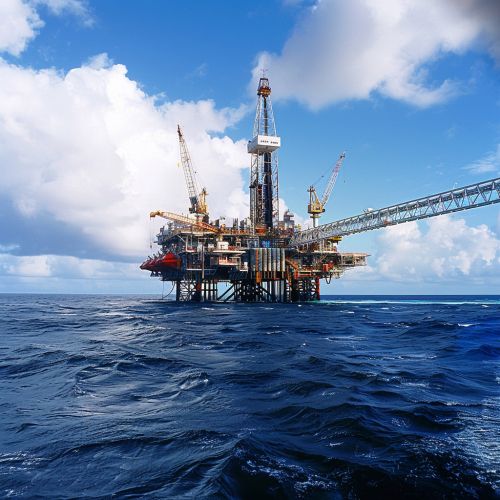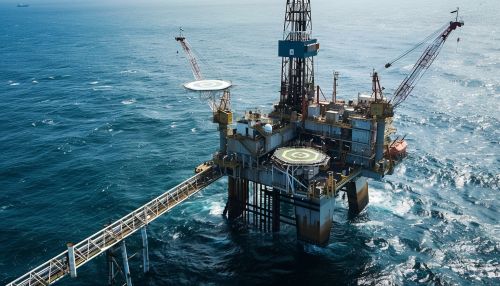Oil and Gas Industry: Difference between revisions
(Created page with "== Overview == The oil and gas industry is a complex and multifaceted sector that plays a critical role in the global economy. It encompasses the exploration, extraction, refining, transportation, and marketing of petroleum products. This industry is divided into three main segments: upstream, midstream, and downstream. Each segment involves specialized processes and technologies, contributing to the overall functionality and efficiency of the industry. == Upstream Sec...") |
No edit summary |
||
| Line 11: | Line 11: | ||
Exploration is the initial phase of the upstream sector, where geologists and geophysicists employ various techniques to locate potential hydrocarbon deposits. These techniques include seismic surveys, which use sound waves to create detailed images of subsurface rock formations, and magnetic surveys, which measure variations in the Earth's magnetic field. | Exploration is the initial phase of the upstream sector, where geologists and geophysicists employ various techniques to locate potential hydrocarbon deposits. These techniques include seismic surveys, which use sound waves to create detailed images of subsurface rock formations, and magnetic surveys, which measure variations in the Earth's magnetic field. | ||
[[Image:Detail-92079.jpg|thumb|center|An offshore oil rig operating in the ocean.|class=only_on_mobile]] | |||
[[Image:Detail-92080.jpg|thumb|center|An offshore oil rig operating in the ocean.|class=only_on_desktop]] | |||
=== Drilling === | === Drilling === | ||
Latest revision as of 07:21, 18 June 2024
Overview
The oil and gas industry is a complex and multifaceted sector that plays a critical role in the global economy. It encompasses the exploration, extraction, refining, transportation, and marketing of petroleum products. This industry is divided into three main segments: upstream, midstream, and downstream. Each segment involves specialized processes and technologies, contributing to the overall functionality and efficiency of the industry.
Upstream Sector
The upstream sector, also known as exploration and production (E&P), involves the search for underwater and underground crude oil and natural gas fields, drilling exploratory wells, and subsequently drilling and operating the wells that recover and bring the crude oil or raw natural gas to the surface.
Exploration
Exploration is the initial phase of the upstream sector, where geologists and geophysicists employ various techniques to locate potential hydrocarbon deposits. These techniques include seismic surveys, which use sound waves to create detailed images of subsurface rock formations, and magnetic surveys, which measure variations in the Earth's magnetic field.


Drilling
Once a potential site is identified, drilling operations commence. This involves the use of drilling rigs, which can be either onshore or offshore. Offshore drilling is particularly challenging due to the harsh marine environment and the need for specialized equipment such as floating rigs and subsea systems.
Production
After successful drilling, the production phase begins. This involves the extraction of hydrocarbons from the reservoir and their initial processing to remove impurities. Enhanced oil recovery (EOR) techniques, such as water flooding and gas injection, are often employed to maximize the extraction of oil and gas from the reservoir.
Midstream Sector
The midstream sector focuses on the transportation, storage, and wholesale marketing of crude or refined petroleum products. This sector serves as the critical link between the upstream and downstream segments.
Transportation
Transportation of oil and gas is primarily conducted through pipelines, which are considered the most efficient and cost-effective method. Other modes of transportation include tankers, railcars, and trucks. The choice of transportation method depends on factors such as distance, terrain, and the volume of hydrocarbons being moved.
Storage
Storage facilities are essential for managing the supply and demand of oil and gas. These facilities include tank farms, underground storage tanks, and liquefied natural gas (LNG) terminals. Proper storage is crucial for maintaining the quality and safety of petroleum products.
Downstream Sector
The downstream sector involves the refining of crude oil, the processing and purifying of raw natural gas, and the marketing and distribution of petroleum products. This sector is responsible for transforming raw hydrocarbons into usable products such as gasoline, diesel, jet fuel, and petrochemicals.
Refining
Refining is a complex process that involves the separation of crude oil into its various components through distillation, followed by further processing to enhance the quality and yield of the final products. Key refining processes include catalytic cracking, hydrocracking, and alkylation.
Petrochemicals
Petrochemicals are chemical products derived from petroleum and natural gas. They serve as the building blocks for a wide range of industrial and consumer goods, including plastics, synthetic rubber, and fertilizers. The production of petrochemicals involves various chemical reactions and processes, such as polymerization and steam cracking.
Environmental and Safety Considerations
The oil and gas industry has significant environmental and safety implications. The extraction and processing of hydrocarbons can lead to air and water pollution, habitat destruction, and greenhouse gas emissions. To mitigate these impacts, the industry adheres to strict regulations and employs advanced technologies for environmental protection and safety management.
Environmental Impact
The environmental impact of the oil and gas industry is a major concern. Activities such as drilling, flaring, and transportation can release pollutants into the atmosphere and water bodies. Oil spills, in particular, pose a severe threat to marine and coastal ecosystems. To address these issues, companies invest in spill prevention and response measures, as well as technologies for reducing emissions and waste.
Safety Measures
Safety is a paramount concern in the oil and gas industry due to the hazardous nature of the operations. Companies implement rigorous safety protocols and training programs to protect workers and prevent accidents. Advanced monitoring systems and emergency response plans are also in place to manage potential risks.
Economic Impact
The oil and gas industry is a major driver of the global economy. It provides employment to millions of people and generates significant revenue for governments through taxes and royalties. The industry's economic impact extends to various sectors, including manufacturing, transportation, and services.
Employment
The industry offers a wide range of job opportunities, from geologists and engineers to technicians and administrative staff. These jobs are often well-paying and provide opportunities for career advancement and professional development.
Revenue Generation
Governments benefit from the oil and gas industry through taxes, royalties, and lease payments. These revenues are used to fund public services and infrastructure projects, contributing to economic development and social welfare.
Technological Advancements
Technological advancements have played a crucial role in the evolution of the oil and gas industry. Innovations in exploration, drilling, and production technologies have enhanced the efficiency and safety of operations, while reducing environmental impact.
Exploration Technologies
Advancements in exploration technologies, such as 3D seismic imaging and remote sensing, have improved the accuracy of hydrocarbon detection and reduced the risk of dry wells. These technologies enable companies to explore previously inaccessible or challenging areas, such as deepwater and arctic regions.
Drilling Technologies
Innovations in drilling technologies, such as horizontal drilling and hydraulic fracturing, have revolutionized the industry. These techniques allow for the extraction of hydrocarbons from unconventional reservoirs, such as shale formations and tight sands, significantly increasing the global supply of oil and gas.
Production Technologies
Enhanced oil recovery (EOR) techniques, such as carbon dioxide injection and thermal recovery, have improved the efficiency of hydrocarbon extraction from mature fields. Additionally, advancements in subsea production systems have enabled the development of deepwater and ultra-deepwater fields.
Future Outlook
The future of the oil and gas industry is shaped by various factors, including technological advancements, regulatory changes, and market dynamics. While the demand for hydrocarbons is expected to remain strong in the near term, the industry faces challenges related to environmental sustainability and the transition to renewable energy sources.
Renewable Energy Transition
The global shift towards renewable energy sources, such as solar, wind, and biofuels, poses a significant challenge to the oil and gas industry. Companies are increasingly investing in renewable energy projects and exploring ways to reduce their carbon footprint. The integration of renewable energy into the existing energy mix is expected to play a key role in the industry's future.
Regulatory Changes
Governments around the world are implementing stricter regulations to address environmental and safety concerns. These regulations include emission reduction targets, stricter safety standards, and incentives for renewable energy development. Compliance with these regulations requires significant investment in new technologies and processes.
Market Dynamics
The oil and gas market is influenced by various factors, including geopolitical events, supply and demand dynamics, and technological advancements. Fluctuations in oil prices can have a profound impact on the industry's profitability and investment decisions. Companies must navigate these market dynamics to remain competitive and sustainable.
Conclusion
The oil and gas industry is a vital component of the global economy, providing energy and raw materials for various sectors. While the industry faces challenges related to environmental sustainability and market dynamics, technological advancements and regulatory changes offer opportunities for growth and innovation. The future of the industry will be shaped by its ability to adapt to these changes and contribute to a sustainable energy future.
